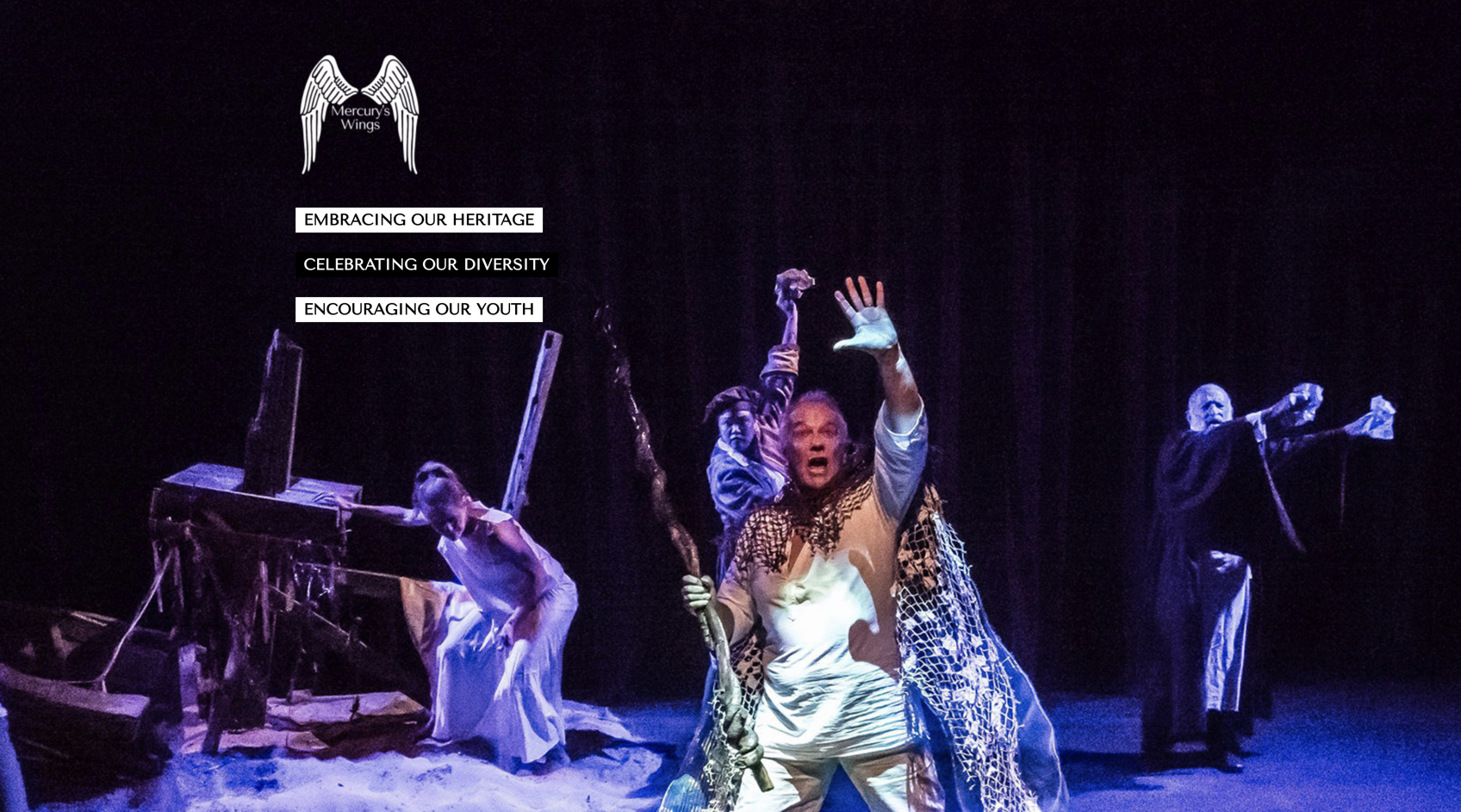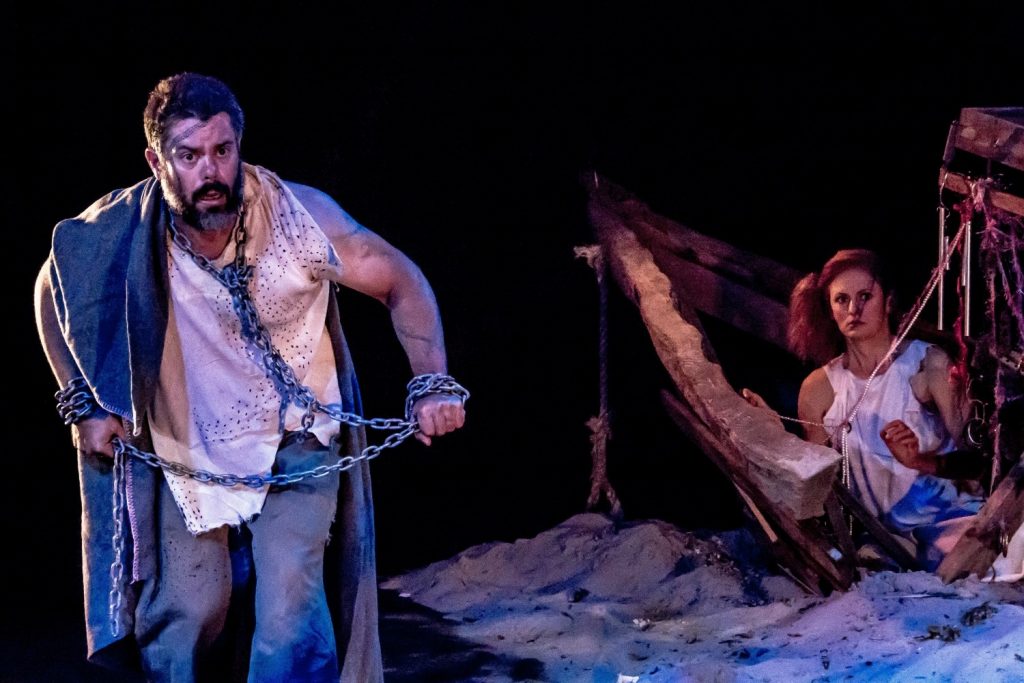I have just viewed a great production of Shakespeare’s Tempest. I don’t say that lightly since the last time I viewed the play was in London’s Middle Temple Hall on the 400th Anniversary of the play in 2011. On that occasion, I thought I ‘died and gone to heaven’ as I reviewed Antic Disposition’s much-lauded production for London’s Fringe Review. As an Australian theatre historian, I know that the comparison might grate a bit. Australian theatre productions are often compared as ‘less than’ some London shows. However, on this occasion, my memory of the 2011 production only serves to remind me that a great production is incomparable with anything that has come before. It takes us beyond just showing another interpretation of a play. Instead, it brings us into the realm of a new vision. It excites the audience to respond to the drama as if it had been created just for their interest and pleasure.
It is from this viewpoint that I believe that Mercury Wing’s Tempest was a beautifully crafted production on many levels. The first element that hit me was the interpretation of Ariel as a most powerful being. Played by Alicia Jones, the character delights in making things happen: she calls the audience into the theatre, she conjures up the storm and, ultimately, she holds Prospero to his bargain to free her. At the same time, Jones’s portrayal of Ariel’s sinewy muscular strength raises questions. Why does she let Prospero use her? His elaborate explanation of freeing her from the witch’s curse, frozen and inanimate in a pine tree, only makes her submission to his control more puzzling. I arrive at a possible answer through Jones’s brilliant display of mercurial shifts when she goes from resistance to embracing him. Oh… really …..she loves him! Not in a sexual, romantic sense but a love that seems to come from wisdom and understanding. She knows Prospero’s need to be reconciled with his past. She knows that his dependency on her will pass and she will stop serving him. In this production, Ariel is ‘every woman’: vulnerable, resilient, life-giving. She makes possible Prospero’s future life.
In balance to this performance of a strong Ariel, Patrick Mitchell’s presentation of Prospero is a tour de force. His presentation of Shakespeare’s demanding poetic language was original and authentic. It was compelling to listen to how each word and line resonated with a well-defined motivation. The actor capitalised on his height and stature to command a kind of ‘rock-star’ presence in his fishing-net cape. I was mesmerised when its fibres caught the light and seemed to make the character look like sparks of light clothed his towering frame. This was my first experience of Mitchell’s acting prowess. I felt cheated by not having had the pleasure of seeing him play epic productions like Shakespeare’s Tempest before. As a mark of his skill, I’m reminded how various Shakespearean experts I’ve listened to over the years have made much about how in Elizabethan drama stage directions are built into the text to give the actor just the right motivation to move, pause and give emphasis through the dialogue. It seems to me that Mitchell’s beautiful voice did not miss a beat. I watched him unearth meanings from the dense poetic text as naturally as if he was speaking in the Australian vernacular. Mitchell was utterly transparent in revealing the character’s meaning. At the same time, it was utterly engaging to listen to him cajole his servant, Ariel, reassure his daughter Miranda and berate the resentful Caliban.
As for the rest of the ensemble, the company members each brought their strengths to play throughout the production. James Anderson’s Caliban was a thoughtfully genuine attempt to pull at the audience’s heartstrings. His chains were a slight against Prospero (and Miranda) for having him confined. The young lovers, Sheree Pipika and Ryan Littler playing Ferdinand and Miranda, were physically and vocally well-matched. They worked well together to show the naturalness of love in the moment, the kind of ‘love can’t wait’. I also very much enjoyed Tracie Filmer’s presentation of Queen Alonsa. She made a very believable interpretation of a role that was originally written as a male role in Shakespeare’s text by focusing on it from the viewpoint of a grieving mother who had lost her son at sea. I felt that she then found interesting nuances to being the relieved mother in the final scene when she greets the return of her son only to discover that he’s upped and married and that she now had a daughter-in-law.
Ms Filmer also doubled as the clown character of Stephano together David Law’s presentation of Trinculo. The three-hander scenes between the drunken clowns and Caliban was a scene worthy of the Three Stooges. Lastly, the wonderful timing in Joel Besken’s delivery of his mock-heroic explanation in his presentation of Gonzalo was also memorable. His foolishness was endearing as a portrayal of the good and faithful servant.
A special mention, I believe, needs to be made of the design of the production. I loved the use of sand, water-ravished wood and tree logs as the basic setting for ‘Prospero’s Island’. Alicia Jones should be commended for the economical use of purely beautiful objects on stage that seemed sculptured into place through time and tide. Her design of costumes was symbolically consistent with the classical tone of the play. Furthermore, her interesting choice of white sand on Australian beaches seems to move around the floor of the stage as if it had a life of its own. Jones’s beautiful minimalistic set was then brought to life through Michael Buenen’s lighting design. The play of light literally made ‘the magic’ come to life in the production.
Conceptually, it seems only fair to end this review by attributing the editing, shaping and sequencing of the drama to its director, Claudine Anderson. Only a director who challenged herself to meet exacting standards could have created the staging that I viewed. It seemed to me that Ms Anderson had done her homework well on Shakespearean dramaturgy and its preoccupation with emblems and symbols. She works the movement of characters on stage as Ariel weaving the coming together of the characters on the island, the arrival of the shipwrecked persons in various vantage points of the landscape and the iconic placement of the stage business on the shipwreck upstage right and the pile of debris downstage left.
Through this iconic use of stage setting, Ms Anderson makes it clear that the island is a space of reconciliation, where the past is revisited in order to move into the future. Her decision to show Ariel and Caliban alone on the island, watching Prospero and other formerly stranded characters leave the island was poignantly haunting. What would happen now? At that moment, I was left in no doubt that being ‘natives’ of a place held its own challenges. I thought, how many times in human history have we imagined that once the colonised are ‘free’ all the problems of the colonised are solved?
Perhaps the only criticism that should be levelled at the company is that the season was too short. Productions as bold as this one deserve an equally imaginative marketing plan to reach a wide audience. To that end, I hope that the company gets a chance to re-run the production. I look forward to the possibility of such a great production to be viewed again and again.

